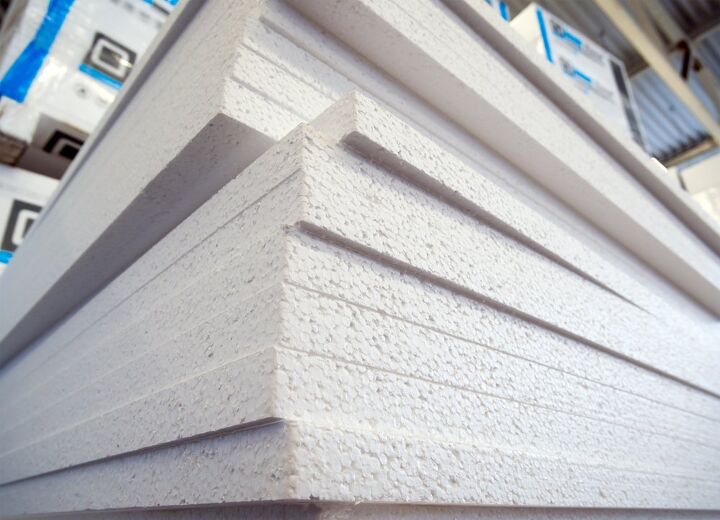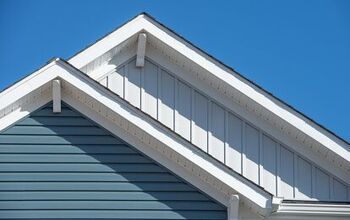Can You Paint Foam Board Insulation?

For controlling temperature and preventing moisture, foam insulation is quite effective. But in a garage or basement, it might look ugly and be unattractive. So, what do you do about the situation? Are you able to paint it?
As long as you use water-based acrylic or latex paint, you can paint foam insulation. Chemicals in paints with oil or solvent bases have the potential to harm foam insulation. Follow the precautions on the can for the best results!
In this article we will cover the best varieties of paint, as well as thorough instructions for painting your foam insulation.
Can You Paint Foam Board Insulation?
Foam board insulate can be painted, although it is recommended to do it with water-based acrylic paint or latex, which can also work.
Because acrylic paint sticks to polystyrene or styrofoam insulation more effectively than other types of paint, this is the reason we’re recommending you use acrylic.
Since this kind of stiff foam board insulation is so porous, it requires several coats of thick adherent paint to be evenly applied to make it look good.
XPS Foam Board
XPS foam board is a different kind of rigid foam board insulation. XPS foam board can also be painted, although latex and acrylic paint won’t stick effectively without a thick coat of primer or a combination of PVA glue and paint.
Solvent-based and oil-based paints should not be used since the compounds in these paints can harm foam board insulation.
Additionally, oil-based paints won’t maintain their color as long as acrylic paint. Acrylic paint is thick enough to cover the foam board’s color fully and is simple to apply to the entire width of rigid foam board insulation.
Why Should I Paint My Foam Insulation?
Foam insulation can be painted for a few reasons. First, it can improve its appearance and appeal. Insulation made of plain foam may appear dated, unfinished, or trashy. It looks homogeneous after painting, and you can choose the color of the room.
If you ever need to replace some of the insulation, it can also be used to make two different foam insulation types or colors look the same.
Paint will also provide an additional layer of defense. Though relatively long-lasting and strong, XPS, polystyrene, and styrofoam insulation can be harmed by water.
When pushing furniture or other objects up against the insulation, they may also become damaged or punctured. Additionally, the layer of protection stops excessive sun damage, especially in outdoor locations.
It will look uniform after being painted, and any dust or grime will be covered up. It will also be simple to reapply or touch up. Additionally, it’s simple to change colors and even add textures or designs.
There are very few drawbacks to painting rigid foam board insulation because painting it is quite unlikely to impact how efficient the insulation is. In some situations, insulating paints can be used to increase the effectiveness and efficiency of foam board insulation. Your energy cost might go down as a result, helping you save money.
Can You Paint Foam Insulation?
You may paint the polyurethane foam as long as you wait a minimum of 24 hours after installing the spray foam insulation.
The best paint to use is elastomeric paint since it shields spray foam from UV rays that might cause damage and keeps the foam from becoming yellow over time.
By defending against deterioration or stopping it from becoming brittle, it might even extend the life of the insulation.
You can definitely use any water-based acrylic or latex paint to create closed-cell spray foam. It is not always necessary to use very thick paint since closed-cell spray foam is tougher and less absorbent. Spray paint can be used with closed-cell spray foam, however, open-cell spray foam shouldn’t be painted with it.
When applying paint, it’s crucial to use a soft brush because open-cell spray foam is softer. You should stay away from thin paints because it is also absorbent.
The best solution for open-cell spray foam is elastomeric paint. Spray foam with open cells melts when exposed to aerosols like spray paint.
Are There Benefits to Painting Foam Insulation?
While painting foam insulation is not required, it could help shield it from UV ray harm. The outside foam insulation of your home is where this is most crucial, but internal insulation can also be protected by paint.
The paint may also assist in lowering the risk of fire when using foam insulation both inside and outside.
This is especially true with spray foam insulation that is combustible. Finally, by shielding it from any harm, a coat of paint may aid in extending the lifespan of both solid boards and spray foam insulation.
Can You Spray Paint Insulation?
There are a few problems even if insulation can be sprayed. First off, a lot of spray paints include solvents in them that will dissolve foam insulation like Styrofoam.
Additionally, open-cell spray foam insulation in particular is susceptible to harm from the aerosol’s force behind the paint. The best technique to spray it is from a distance of at least 1.5 feet from the surface.
Spray paint is effective at creating a smooth covering. However, it is better to use a paint sprayer with latex or acrylic paint that is water-based to prevent potential harm to the insulation. You have control without causing the foam insulation to dissolve or get damaged in any way.
Things to Consider Before Painting Foam Insulation
There are some additional considerations regarding foam insulation and the paint you use to keep in mind.
Fire Rating
First, the fire rating of the foam insulation and the paint is something to keep in mind. While most products are up to code, check your local code or talk to a local home inspector for more information.
Always choose insulation that will keep you safe in your own home and paint that does not make it more flammable.
Most expanding foam insulation, including Great Stuff insulation, is highly flammable. When you first spray the expanding foam, it emits gases and chemicals that are flammable.
It will remain somewhat flammable until it is fully cured. This is an additional reason to avoid oil-based paints that include flammable solvents and chemicals.
Be Careful Where You Apply
Due to its flammability, it is best to avoid applying Great Stuff foam or other expandable foams around heaters, heat lamps, recessed lighting fixtures, radiators, and fireplaces.
It is also best to avoid spray paints around these types of heat sources too, especially if the spray paint contains flammable compounds.
If you are concerned about the fire hazards, then look for fire-resistant paint to use on the foam insulation. These can add to the fire rating of the insulation itself.
Furthermore, if you are painting insulation in an area that is susceptible to water damage, choose water-resistant and mold-resistant paints.
Open Ventilation
You should always ensure that the area is well-ventilated before painting. You may also want to keep children and pets away from the area while you are painting.
It is also best to use flat or semi-gloss paint because it will hide any irregularities in the foam insulation. High-gloss, on the other hand, will make any bumps or creases more noticeable.
How Do You Paint Foam Insulation?
Before you move forward with painting the foam insulation, you must wait until the foam insulation is fully cured.
While some foam insulation says that it cures in 8 hours, it is best to wait at least 24 hours before painting. This ensures that it is fully dried. Painting before it is fully dry can damage the insulation.
Before painting, you will want to sand the foam insulation. While sanding, be sure to wear a mask to protect against inhaling particles of insulation.
Use sandpaper to make the ends and edges of the foam smooth. While this step isn’t the most important, it can make the finished project look much better and more uniform.
Sanding Foam Insulation
Sanding is most important for spray foam and expanding foam insulations. This is because those are more textured than rigid foam board insulation.
With spray foam, it is also best to use a paint sprayer because of the irregularities. You can always touch up with a brush to get hard to reach spots.
How to Paint Foam Insulation Board
After you finish sanding and preparing the insulation, you can move forward with the painting. Before you can paint though, you should apply primer.
Apply Primer
You can use PVA glue, gesso, or latex house paint as a primer for foam insulation boards. Make sure that you apply your choice of primer evenly in thin layers.
You can use a roller for most of the insulation and then get the corners and hard-to-reach areas using a brush. The primer will also prevent the paint from being absorbed into the insulation.
Apply Paint
After waiting for the primer to fully dry, you can move on to the painting. You can use brushes or paint rollers, but make sure you don’t leave drips that can lead to streaks or bumps on the surface.
You will probably want to do at least two layers to fully cover the foam insulation. Wait for the paint to fully dry before applying a second layer.
What Kind of Paint to Use on Foam Insulation?
As long as you choose water-based acrylic or latex paint, you can use it on foam insulation. It is also important to consider the thickness of the paint.
Thin paints can be absorbed by some types of insulation, so a thicker paint can work better for applying an even layer.

Heather is a passionate writer who loves anything DIY. Growing up, she learned everything from home repairs to design, and wants to share her tips with you. When she's not writing, she's usually hiking or searching for her next DIY project.
More by Heather Robbins

















![Standard Dining Room Table Dimensions [for 4, 6, 8, 10 and 12 People]](https://cdn-fastly.upgradedhome.com/media/2023/07/31/9074335/standard-dining-room-table-dimensions-for-4-6-8-10-and-12-people.jpg?size=350x220)


![10 Most Dangerous Neighborhoods in Baltimore [Updated]](https://cdn-fastly.upgradedhome.com/media/2023/07/31/9075655/10-most-dangerous-neighborhoods-in-baltimore-updated.jpg?size=350x220)






